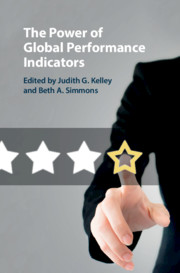Book contents
- The Power of Global Performance Indicators
- The Power of Global Performance Indicators
- Copyright page
- Contents
- Figures
- Tables
- Contributors
- Preface
- 1 Introduction
- Part I Ratings, Rankings, and Regulatory Behavior
- Part II The Normative Influence of Ratings and Rankings
- Part III Beyond and Within State
- 9 Can Blacklisting Reduce Terrorist Attacks?
- 10 Assessing International Organizations
- Part IV Skeptical Voices
- Index
- Chapter 3: Appendices
- Chapter 4: Appendices
- Chapter 5: Appendix
- Chapter 6: Appendix
- Chapter 7: Appendix
- Chapter 8: Appendix
- Chapter 10: Appendix
- Chapter 11: Appendix
- Chapter 12: Appendix
- References
10 - Assessing International Organizations
Competition, Collaboration, and Politics of Funding
from Part III - Beyond and Within State
Published online by Cambridge University Press: 28 February 2020
- The Power of Global Performance Indicators
- The Power of Global Performance Indicators
- Copyright page
- Contents
- Figures
- Tables
- Contributors
- Preface
- 1 Introduction
- Part I Ratings, Rankings, and Regulatory Behavior
- Part II The Normative Influence of Ratings and Rankings
- Part III Beyond and Within State
- 9 Can Blacklisting Reduce Terrorist Attacks?
- 10 Assessing International Organizations
- Part IV Skeptical Voices
- Index
- Chapter 3: Appendices
- Chapter 4: Appendices
- Chapter 5: Appendix
- Chapter 6: Appendix
- Chapter 7: Appendix
- Chapter 8: Appendix
- Chapter 10: Appendix
- Chapter 11: Appendix
- Chapter 12: Appendix
- References
Summary
During the past decade, states have initiated a striking trend in global governance: the creation and promulgation of indicators of the performance of international organizations (IOs). These Global Performance Indicators (GPIs) were developed to help policymakers make more efficient use of their multilateral funding in the context of budgetary pressures induced by the global economic crisis. Puzzlingly, however, not all IOs that have received high ratings have been “rewarded” with increased financial contributions, while not all IOs that have received low ratings have been “punished” with funding cuts or freezes. This chapter examines when and why IO performance indicators influence resource flows to these institutions. Analyzing ratings as a form of social knowledge, I develop an argument that highlights how different aspects of the relationship between IOs and other actors within their policy space mediate the financial effects of such knowledge. I posit that resource flows are only responsive to ratings when one of two relational conditions is satisfied: (1) IOs face a high degree of institutional competition; and (2) IOs have robust governance partnerships with non-state actors. I test the argument using a mixed-methods approach, combining qualitative evidence from interviews and other sources with statistical analyses – both observational and quasi-experimental – based on an original dataset covering all six sets of indicators issued thus far. In addition to highlighting an important area in which GPIs have emerged in recent years, the chapter enhances our understanding of the scope conditions for their effects.
Keywords
- Type
- Chapter
- Information
- The Power of Global Performance Indicators , pp. 300 - 338Publisher: Cambridge University PressPrint publication year: 2020
References
- 1
- Cited by

